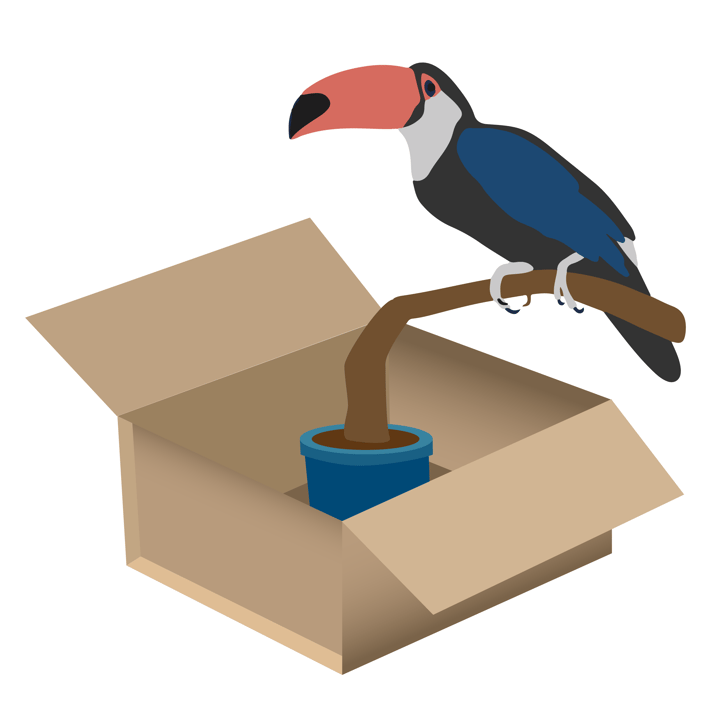- Resources
- CITES-compliant to Switzerland
CITES-compliant – Guidelines for cross-border e-commerce with exotic animals and plants in Switzerland

You’re correct! As an e-commerce retailer, you have to take the CITES convention on fauna and flora into account. “CITES? Like websites?” you might be wondering.
No, it’s nothing to do with websites. In this blog post, we will reveal the secrets of the CITES convention and explain what it is, how you can organize your cross-border e-commerce into Switzerland sensibly and efficiently, and what special provisions you have to observe in order to satisfy the customs authorities.
Do you already sell your products internationally and now also want to deliver to customers in Switzerland? Perhaps you already do? Then you already know that customs clearance for your goods can be quite complicated.
The right shipping solution can not only save time and money, but also massively reduce the complexity of customs procedures. In this way, you can reap the multiple benefits of optimized logistics.
Does all this sound like a challenge? Don't worry, we're here to help. Start chatting on WhatsApp to turn the complex customs procedures into a smooth process. Let's overcome the challenges together!
Swiss e-commerce and endangered species – what is the CITES convention?
The jungle of bureaucracy and customs regulations is home to a very special convention known as CITES, which came into being in 1973. Its full name is the “Convention on International Trade in Endangered Species of Wild Fauna and Flora”, and it has now been adopted by almost every country in the world. It is an international agreement that regulates trade in endangered animal and plant species in order to protect them for posterity from poachers and other dangers.
.jpg?width=426&height=353&name=pexels-maria-isabella-bernotti-2570524%20(1).jpg)
As an e-commerce trader, you are sure to be interested in protecting cute parrots and turtles from extinction, so it is essential for you to fully understand the CITES treaty and its regulations for cross-border trade into Switzerland. Over 5'000 animal species and over 28'000 plant species are now protected by the CITES convention, so you should definitely check whether your goods are also affected.
But a good conscience and reputation are not the only reasons to follow the CITES regulations. If you do not comply with the CITES convention, you will soon encounter trouble with the customs authorities, problems with customs clearance for your goods and difficulty delivering to your customers on time. This means that cross-border imports into Switzerland can quickly become a headache that will strain your nerves and your wallet.
To ensure this doesn’t happen to you, we will look at how and where you can get the correct permit and other documents that meet the Swiss CITES Ordinance and what special provisions apply to CITES flora and fauna cross-border e-commerce.
Flora, fauna and fun – trade in compliance with CITES and profit with a clear conscience in Switzerland
The Swiss CITES Ordinance has a single purpose: to regulate the exploitation of wild and endangered animal and plant species and to ensure that crocodiles, rhinos and parrots still exist in 100 years’ time. For this reason, goods that contain the relevant animal and plant species must be properly certified when they are imported into Switzerland.
The CITES regulations cover three appendices. Appendix I represents the highest level of protection and lists around 1,000 animal species that are subject to a full trading ban. These include elephants (which means ivory chess pieces are prohibited!), rhinos, certain precious woods and some types of orchids. Species listed in Appendices II and III, such as cacti, crocodiles, wolves, most parrot species, etc., may be traded only in a certified and controlled manner.
Pro tip
Be aware that the List of protected animal and plant species is updated regularly. Stay up to date and always check that your goods are CITES-compliant.
Pro tip
Be aware that the List of protected animal and plant species is updated regularly. Stay up to date and always check that your goods are CITES-compliant.
In conclusion: when importing CITES goods into Switzerland, it is important that you remain well informed, well organized and well connected.
Digital and sustainable – get to grips with CITES-compliant cross-border e-commerce
Let’s imagine you would like to import crocodile leather bags from Ghana into Switzerland.
Apart from species protection, which is a complex matter in itself, you will also have to organize efficient and proper customs clearance. A customs clearance process might proceed more or less as follows:
- CITES trading permit: You must first obtain a valid export permit from the competent authority in the country of origin of the crocodile leather bags. You must then apply for an import permit from the Federal Food Safety and Veterinary Office (FSVO) in Switzerland.
- Import declaration: Report the crocodile leather bags to the Federal Office for Customs and Border Security (FOCBS) before they are sent to Switzerland. Use the electronic customs declaration system (e-dec) for the declaration. The digital declaration usually takes about 24 hours.
- Submit CITES documents: Submit the originals of the export and import permit documents along with the customs declaration before the crocodile leather bags reach Switzerland.
- Control and inspection: When the crocodile leather bags are imported, the customs authorities and the FSVO can check the goods for compliance with the permits. Provided everything is in order, you will receive an import permit.
- Customs clearance and VAT: After the CITES documents and crocodile leather bags have been inspected and approved, you must pay the import levies and VAT. The amount of the levy depends on the type and value of the bags.
- Customs clearance: As soon as you have paid the customs levies and VAT, you will be granted customs clearance for your crocodile leather bags, and they can be imported into Switzerland.
You will probably want to import your crocodile leather bags into Switzerland more than once and operate regular cross-border e-commerce for them. Constantly obtaining the relevant permits will become quite tiresome. In this case, you have the option of registering your commercial CITES import operations and applying for a permanent import permit. This allows you to import crocodile leather bags for two years without having to get a new permit every time!
The Tares customs tariff tool can provide a lot of important information such as possible customs duties, additional charges, licensing requirements, etc. To find the relevant information, you must first enter the date, the export and import country and the tariff number, which you can easily find in the overview.
Apart from complete bans (Appendix I), such as for ivory or shahtoosh shawls, which may not be imported almost without exception, there are special provisions for some permitted goods. It may be that you need additional import permits or that you are allowed to import only a limited amount at certain times of the year.
It would be impractical to list every possible rule with exceptions in this blog post. You must therefore look for suitable and up-to-date provisions for your specific case. As a general rule, you must be able to prove the origin or provenance of your goods and whether you are entitled to have possession of them.
To ensure the whole process runs smoothly and efficiently, it’s a good idea to hire an experienced customs agent or forwarder to help you comply with regulations and handle customs clearance processes.
This reduces your workload and avoids mistakes. When working with an expert, all you have to do is provide them with the following information:
- Item number and item link (so the item can be identified in the shop)
- Item description and item material (so that the expert can assess whether the product is critical)
- Customs tariff number (so the expert can compare the item with the Swiss customs system)
If a CITES expert determines that your product is a CITES-critical product, they can work with you to determine what measures should be taken. A sensible measure might be to block the product in Switzerland because the whole process is not worth the aggravation.
If it is your core business or an essential part of your shop, you can initiate the appropriate approval process. Here, too, we recommend that you find competent support to avoid difficulties with logistics and in order to take into account opportunities and calculated risks right from the start.
Switzerland, the e-commerce mecca – best practices for sales success
You will have gathered that CITES is a complicated issue that poses many challenges for non-experts. Here are our recommendations to help you avoid any serious mistakes.
- Gather all the documents you need for the import BEFORE sending the goods to Switzerland.
- Always stay up to date, observe special regulations and pay attention to legal updates from customs authorities and other relevant institutions.
- Establish smooth communication with your trusted forwarder who is familiar with CITES customs clearance and imports and (if necessary) with the relevant customs authorities.
- Use data automation. Use a digital customs clearance system for your e-commerce platform. Use AI tools that compare your goods with current legal regulations and inform you of changes.
In conclusion: when importing CITES goods into Switzerland, it is important that you remain well informed, well organized and well connected
The CITES journey – problems and challenges in customs clearance in Switzerland
Of course, even with the best preparation in the world, mistakes can still happen during customs clearance. Of the many challenges that we cannot list in full, these three are typical:
- Delays in delivery are a common occurrence. They can often be avoided with good preparation and complete documentation, but there is no such thing as an absolute guarantee for CITES goods.
- Missing or incorrect documents are a typical challenge. In these cases, it is definitely advisable to seek help from experienced forwarders who can correctly allocate and document your goods.
- Customs clearance of CITES goods can be quite expensive in Switzerland, because the goods are subject to high fees based on category, quantity, etc. Here, too, incorrect information can drive up the costs even more, which is why we recommend getting help.
Don’t let the specifications confuse you! Cross-border e-commerce with CITES goods can be profitable, it’s just a question of technology and a clever strategy! And don’t forget that the CITES Ordinance is not there just to annoy you, but to protect endangered animals and plants. Carbon-neutral delivery to Switerland makes your logistics even more sustainable and helps to protect the environment.
CITES compliance gives your cross-border e-commerce wings
As an e-commerce retailer who wants to import exotic goods into Switzerland, you can find aspects of the CITES convention useful. Apart from ensuring that you are acting legally and avoiding penalties, you can tap into lucrative niche markets with little competition. The Swiss market in particular is extremely profitable and offers unique sales opportunities in the luxury segment.

If you comply with the protection regulations and can demonstrate that you have a valid permit, you are signalling to your customers that you are a responsible dealer who can be trusted. Sustainable and environmentally aware trading shows that you disclose where your goods come from, which can only be good for your image.
And a positive image in a niche market increases the likelihood of higher sales due to excellent customer loyalty. This includes word of mouth, repeat purchases and better search engine ratings.
Last but not least, you avoid delays, returns or confiscations by the Swiss customs authorities if you prepare for customs clearance meticulously. This not only optimizes your service quality and delivery times, but also saves massively on opportunity costs and general hassle. In Switzerland, violations of CITES regulations are punishable with a fine of up to CHF 20'000. It also enables you to sell larger quantities, making your cross-border e-commerce business more efficient and profitable.
The CITES fees safari – let’s go on an adventure through the fee landscape!
If you are importing CITES flora and/or CITES fauna goods into Switzerland, you will have to pay various fees in addition to VAT. These are set differently for the CITES flora and the CITES fauna product groups.
CITES flora fees
When importing CITES plants such as orchids from non-EU countries into Switzerland, you must pay a basic fee and an additional fee. The basic fee is CHF 50 per phytosanitary certificate. The additional fee depends on the number of items.
For example, a single orchid (one item) with a phytosanitary certificate would require a fee of CHF 60. Three orchids with a phytosanitary certificate would require a fee of CHF 80. If you are importing ten orchids from different production sites (two phytosanitary certificates with five items each) into Switzerland, the fee will be around CHF 200.
However, you do not necessarily have to be importing live plants to be subject to the CITES flora fee. For example, if you are selling sweaters with buttons made from CITES-protected precious wood, the fee is also due.
In addition, living plants must be physically inspected, with the inspection incurring an additional fee of CHF 60. A document check without physical inspection is CHF 30. The fees are not included in the customs declaration and are only added afterwards.
CITES fauna fees
The fees for the inspection of animals and animal products during customs clearance of CITES fauna products are set by the competent authorities, in particular the Federal Food Safety and Veterinary Office (FSVO). Inspection fees may vary depending on the type of product, the size of the shipment and the required inspection workload.
Depending on the nature of the imported CITES fauna products, the inspection may require either a physical examination of the goods or a review of the corresponding documentation. Fees may vary depending on the type and scope of the inspection.
The size of the shipment, the number of animals or animal products involved, the weight and the number of different CITES species can also affect the inspection fees.
In some cases, additional testing or analysis may be required to verify compliance with CITES and national regulations. This may apply, for example, to beef from countries with no ban on growth hormones. The cost of such testing or analysis may increase the inspection fees.
The competent authorities may also charge additional administrative fees for processing applications, issuing permits or certificates and conducting inspections.
The exact fees for the inspection of animals and animal products during customs clearance for CITES fauna products imported into Switzerland can vary massively. You should therefore obtain information from the competent authority in good time or get in touch with your CITES-competent forwarder.
Conclusion
Firstly, congratulations! You have learned about this extensive and complex topic and are now smarter than before.
You have just discovered how e-commerce retailers can import exotic animals and plants into Switzerland in a CITES-compliant manner. Key takeaways:
- CITES convention: A smart agreement that protects endangered species − and you now know exactly what it stands for.
- Appendices I, II and III: Are you now familiar with all three? Great! You now know which species can be traded and which goods are strictly prohibited from trading.
- Swiss CITES Ordinance: Certificates are mandatory! Get everything ready BEFORE you send off your goods.
- Customs clearance: This can be a bit of an adventure – but with the right preparation and automation, it’s not a problem.
- Customs agent or forwarder: Your personal assistant who can help you comply with CITES regulations or develop sensible customs clearance strategies. Looking for an expert will save you a lot of hassle!
- Permanent import permit: Perfect for frequent importers – apply once and use it for longer.
- Advantages: It pays to trade responsibly – cultivate lucrative niche markets, a positive image and loyal customers.
Individuelle Lösungen für einzigartige Bedürfnisse
Mit der persönlichen Beratung zum optimalen Versand- und Logistiksetup
Bei der Schweizerischen Post verstehen wir, dass jeder Markt seine eigenen, einzigartigen Herausforderungen hat. Deshalb sind wir hier, um Dich beim Export in die Schweiz oder beim Export aus der Schweiz zu unterstützen. Mit unserer umfassenden Erfahrung und unserem massgeschneiderten Ansatz finden wir gemeinsam die optimale Lösung für Dein Versand- und Logistik-Setup.
Warum einen Beratungstermin bei uns buchen?
-
Massgeschneiderte Lösungen
-
Umfassende Expertise
-
Einfacher Prozess
-
Vertrauenswürdiger Partner
Customised solutions for unique needs
Personalised advice for the optimal shipping and logistics setup
At Swiss Post, we understand that every market has its own unique challenges. That's why we're here to help you export to or from Switzerland. With our extensive experience and customised approach, together we will find the optimal solution for your shipping and logistics setup.
Why book a consultation with us?
- Customised solutions
- Comprehensive expertise
- Simple process
- Trusted partner
Des solutions personnalisées pour des besoins uniques
Un conseil personnalisé pour une configuration optimale de l'expédition et de la logistique
A la Poste Suisse, nous comprenons que chaque marché a ses propres défis uniques. C'est pourquoi nous sommes là pour vous aider à exporter vers la Suisse ou à exporter depuis la Suisse. Grâce à notre vaste expérience et à notre approche sur mesure, nous trouverons ensemble la solution optimale pour votre configuration d'expédition et de logistique.
Pourquoi réserver un rendez-vous de conseil avec nous ?
- Des solutions sur mesure
- Une expertise complète
- Processus simple
- Un partenaire de confiance
Soluzioni personalizzate per esigenze uniche
Consulenza personalizzata per l'impostazione ottimale della spedizione e della logistica
Noi della Posta Svizzera sappiamo che ogni mercato ha le sue sfide uniche. Ecco perché siamo qui per aiutarla ad esportare da o verso la Svizzera. Grazie alla nostra vasta esperienza e all'approccio personalizzato, insieme troveremo la soluzione ottimale per il suo setup di spedizione e logistica.
Perché prenotare una consulenza con noi?
- Soluzioni personalizzate
- Competenza completa
- Processo semplice
- Partner affidabile





